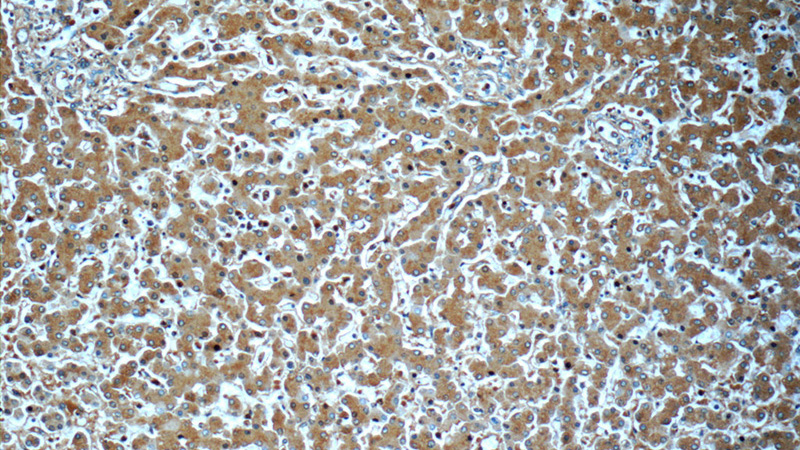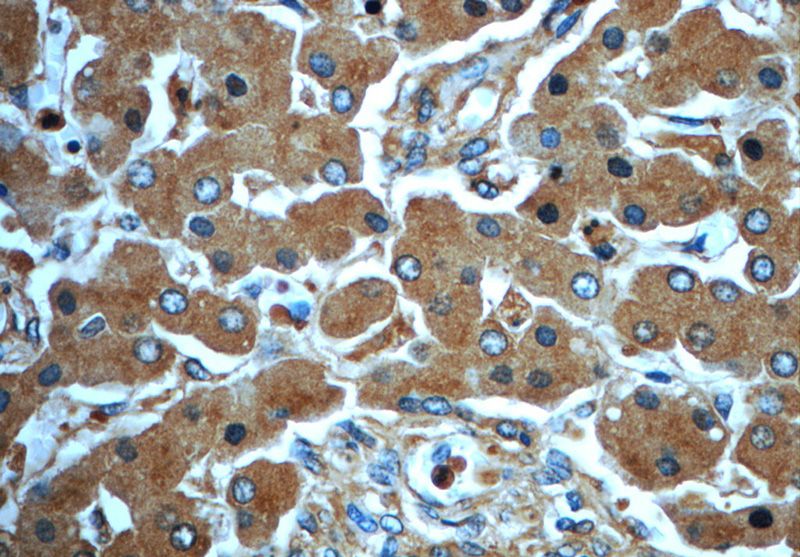-
Product Name
ORM1 antibody
- Documents
-
Description
ORM1 Rabbit Polyclonal antibody. Positive IP detected in human plasma tissue. Positive WB detected in mouse liver tissue, mouse bladder tissue. Positive IHC detected in human liver tissue. Observed molecular weight by Western-blot: 41-47kd
-
Tested applications
ELISA, WB, IHC, IP
-
Species reactivity
Human, Mouse; other species not tested.
-
Alternative names
AGP 1 antibody; AGP A antibody; AGP1 antibody; Alpha 1 acid glycoprotein 1 antibody; OMD 1 antibody; ORM antibody; ORM1 antibody; orosomucoid 1 antibody
-
Isotype
Rabbit IgG
-
Preparation
This antibody was obtained by immunization of ORM1 recombinant protein (Accession Number: NM_000607). Purification method: Antigen affinity purified.
-
Clonality
Polyclonal
-
Formulation
PBS with 0.1% sodium azide and 50% glycerol pH 7.3.
-
Storage instructions
Store at -20℃. DO NOT ALIQUOT
-
Applications
Recommended Dilution:
WB: 1:500-1:5000
IP: 1:200-1:1000
IHC: 1:20-1:200
-
Validations

mouse liver tissue were subjected to SDS PAGE followed by western blot with Catalog No:113425(ORM1 antibody) at dilution of 1:1000

Immunohistochemistry of paraffin-embedded human liver slide using Catalog No:113425(ORM1 Antibody) at dilution of 1:50

Immunohistochemistry of paraffin-embedded human liver slide using Catalog No:113425(ORM1 Antibody) at dilution of 1:50

IP Result of anti-ORM1 (IP:Catalog No:113425, 3ug; Detection:Catalog No:113425 1:300) with human plasma tissue lysate 100ug.
-
Background
Alpha-1-acid glycoprotein 1 (AGP1), also called orosomucoid-1 (ORM1), is a glycoprotein synthesized mostly by hepatocytes and present in human plasma. ORM1 is an acute-phase reactant protein controlled by glucocorticoids, interleukin-1 and interleukin-6, and increase up to 5-50 times upon infection and/or inflammation. Anti-apoptotic effect and role as immunomodulator of ORM have been reported. ORM is an important carrier for synthetic drugs and influences their distribution and availability in the body. This antibody recognizes a band about 44 kDa in human plasma which may be due to the glycosylation of ORM1 or the dimer formation of the protein.
Related Products / Services
Please note: All products are "FOR RESEARCH USE ONLY AND ARE NOT INTENDED FOR DIAGNOSTIC OR THERAPEUTIC USE"
